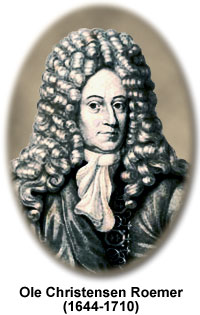Ole Christensen Roemer
(1644-1710)

Ole Christensen Roemer was the son of a merchant, born in Aarhus, Denmark on September 25, 1644. He attended Aarhus Cathedral School in his youth and upon graduation in 1662 was sent to Copenhagen University. There he lived and studied with Erasmus Bartholin, a professor of medicine better known for his discovery of double refraction in Iceland spar. Bartholin greatly esteemed Roemer and appointed him the task of editing Tycho Brahe's manuscripts. Roemer carried on the project from 1664 to 1670 and, in 1671, journeyed to Hveen with Bartholin and Jean Picard in order to observe Brahe's observatory.
In 1672, Roemer accompanied Picard back to France and began working at the Royal Observatory in Paris. Soon after, he was appointed astronomy tutor of the Dauphin by King Louis XIV, but also continued research at the observatory under the patronage of the French Academy of Sciences. While there, he became revered for his mechanical skill and inventive mind. He constructed several planispheres, a Saturnilabium, a Jovilabium, and an advanced micrometer that was quickly adopted into general use. In 1679, he was sent to England to examine the measurement capabilities of a pendulum being constructed by the Royal Society and met many of the top scientific minds of the day, including Sir Isaac Newton, John Flamsteed, and Edmond Halley.
Roemer' s greatest achievement, however, was the first relatively accurate measurement of the speed of light, a feat he accomplished in 1676. At the Royal Observatory, Roemer's studies of Jupiter's moon Io and its frequent eclipses enabled him to predict the periodicity of an eclipse period for the moon. However, after several months, he noticed that his predictions were slowly becoming less accurate by progressively longer intervals of time, culminating in a maximum error of about 22 minutes. Then, just as strangely, his predictions again became more accurate over a several month period, a cycle that continuously repeated itself. Roemer soon realized that the observed disparities were produced by variations in the distance between the Earth and Jupiter caused by the orbital movement of the planets. As Jupiter moved away from the Earth, light had a longer distance to travel and, therefore, took additional time to reach the Earth. By applying the relatively inaccurate calculations for the distances between Earth and Jupiter available during the seventeenth century, Roemer was able to approximate the speed of light to be 137,000 miles (or 220,000 kilometers) per second.
Speed of Light - Starting with Ole Roemer's 1676 breakthrough endeavors, the speed of light has been measured at least 163 times by more than 100 investigators utilizing a wide variety of different techniques. Finally in 1983, more than 300 years after the first serious measurement attempt, the speed of light was defined as being 299,792.458 kilometers per second by the Seventeenth General Congress on Weights and Measures. Thus, the meter is defined as the distance light travels through a vacuum during a time interval of 1/299,792,458 seconds. In general, however, (even in many scientific calculations) the speed of light is rounded to 300,000 kilometers (or 186,000 miles) per second.
